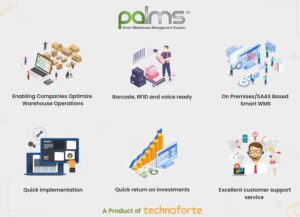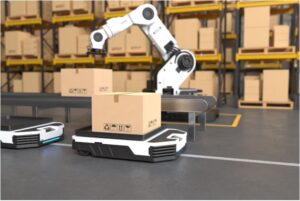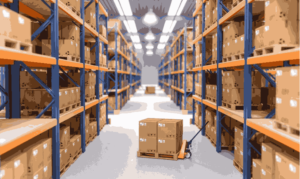31/05/2023
Warehouse automation is a crucial aspect of supply chain management that has been undergoing significant changes in recent years due to the evolution of technology. The use of automated systems in warehouses has improved efficiency, reduced errors, and increased productivity while lowering labor costs.
In this article, we will look at the trends in warehousing automation solutions.
What is Warehouse Automation?
Warehouse automation involves the use of technology to substitute manual labor performing repetitive tasks with automated systems, so that skilled labor can shift their focus elsewhere, to more productive operations.
But what is the scope of this technology?
It encompasses a range of different systems, from simple conveyors to sophisticated robots that can perform complex tasks. They can be implemented in every phase of operations, including receiving, put away, picking, sorting, data analytics and so on.
Automation can be implemented in a warehouse with differing levels of complexity depending on requirements and budgets. There is no single solution that fits all warehouses.
For some businesses, partially automated warehouses, where only particular steps in the workflow are automated, may be a better fit. These can include technologies like automated conveyor systems, robotic picking and sorting systems, automated guided vehicles (AGVs), or even advanced warehouse management software. The other aspects of warehouse operations, for example, complex decision-making or tasks that require fine motor skills, still rely on the involvement of the human workforce.
Past Methods of Warehouse Management vs New Automation Trends
Old methods of warehouse management have been phased out over the past decade to make way for the implementation of AI and WMS software. The WMS software allows warehouse managers to gain real-time visibility on all receiving, inventory control, and order management activities for several warehouses on the same platform. It also delivers the ability to receive detailed analytical inputs on the various areas of improvement in warehouse operations. For example, the WMS can apply ABC analysis to improve the storage allocation in the warehouse. It can also help improve the number of backorders.
The latest iteration of WMS software has improved enormously on the way things used to be done in warehouses:
| Past Warehouse Management Methods | New Automation Trends |
| Manual inventory tracking and management | Automated inventory tracking and management using RFID and barcodes |
| Use of paper-based documentation | Paperless documentation with the use of electronic data interchange (EDI) |
| Manual order picking and packing | Automated order picking and packing using robots and automated storage and retrieval systems (AS/RS) |
| Limited use of technology | Use of technology such as artificial intelligence (AI), machine learning (ML), and the Internet of Things (IoT) |
| High reliance on manual labor | Reduced reliance on manual labor |
The Benefits of Warehouse Automation
It is evident that automated systems reduce reliance on manual labor, which translates to reduced errors, and improved efficiency and productivity. Besides these, there are manifold benefits of adopting new warehouse automation technology, as listed below:
- Maximized space utilization: Making narrow aisles with higher shelves and greater storage per unit area, system suggested location, consolidation of inventory based on system suggestion, machine learning to plan for future orders are some strategies that can be deployed to maximize space with the help of automation.
- Reduced turnaround time: Warehouse automation may have high initial setup costs, but the benefit far outweighs the risk. Remember, an inefficiently run warehouse is going to be far more expensive in the long run.
- Quick Upscaling: Demand is a volatile thing. A key benefit of warehouse automation solutions is that they can scale up as required.
- Sustainability: Warehouse automation can provide many long-term solutions including better service, efficient energy use, lower costs and improved data accuracy.
Warehouse Automation Trends
Warehouse automation companies have been ramping up research and development efforts in order to develop better technology. Some futuristic technologies you may encounter in warehouses in recent years are:
Robotics:
Robotics is the most significant trend in warehouse automation. With advancements in robotics technology, collaborative robots (or cobots) are being used for more complex tasks such as order picking, packing, and even unloading trucks.
A recent study found that cobots can increase efficiency by almost 30%!
Cobots have also become more affordable, making them accessible to small and medium-sized businesses.

Artificial Intelligence (AI) and Machine Learning (ML):
AI and machine learning for the purposes of inventory control and warehouse automation are becoming more prevalent in recent years. They have multiple applications in areas like data analytics, picking and packing processes, logistics, IoT sensors, RFID and so on. For example, they have the ability to predict demand and optimize inventory levels, reducing the need for excess inventory.
According to the BCI’s Supply Chain Resilience Report, 69% of companies still don’t have complete visibility of their supply chain. This is one of the primary issues AI has been trying to address in supply chain management.
AI and ML implementation can improve on a number of key areas:
- Resource planning
- Supplier relationship management
- Technical downtimes
- Transportation costs
- Quality and safety
Internet of Things (IoT):
The Internet of Things (IoT) refers to a network of connected devices that allows for interaction and sharing of information in ways that will improve efficiency and coordination. In the context of warehouses, this may refer to warehouse management systems, fleet management systems, predictive maintenance software and so on.
IoT devices such as sensors, RFID tags, and beacons are used to track inventory and monitor warehouse conditions such as temperature and humidity. This data is then analyzed using AI and ML algorithms to optimize warehouse operations.
An industrial IoT in your warehouse ultimately leads to:
- Filling gaps that cause inefficiencies spotted by the software
- Reduce unexpected downtime or equipment being used inefficiently
- Informed decision making with all the data on hand
Cloud-Based Warehouse Management Systems (WMS):
Cloud-based WMS has become an indispensable part of many warehouses due to its scalability, affordability, and accessibility. It allows businesses to manage their warehouse operations from anywhere in the world, reducing the need for on-premise hardware and software and cutting maintenance costs.

You may like to check our top-of-the-shelf cloud-based WMS software PALMS™.
Automated Storage and Retrieval Systems (AS/RS):
AS/RS systems are used to automate the process of storing and retrieving inventory. They are machines that follow a pre-set route and automatically get materials. They are available in a variety of configurations, including machines like carousels, cranes, vertical lift modules (VLMs) or shuttles.
These systems are used to increase operational efficiency and reduce errors, especially in large warehouses with high-volume inventory.

Autonomous Mobile Robots (AMRs) & Automated Guided Vehicles (AGVs):
Autonomous mobile robots (AMRs) move across the warehouse floor to transport goods from one location to another. They can function without an onboard operator.

Automated guided vehicles (AGVs) work in a similar manner, but require an onboard operator.

They are used for order picking, reducing frequency of repetitive actions and the time and labor required for these tasks.
Wearables
Wearable technology has started to become more commonplace due to its portability and convenience. Devices like augmented reality smart glasses, GPS tracking bracelets and finger trigger gloves are equipped with smart sensors that can help with stocking, receiving, navigating, shipping and even instructions on lifting objects. This means lesser paperwork and workers freed up to focus on picking tasks.

Voice Picking
Voice picking systems are typically integrated with the WMS or ERP system. They are a method to manage order fulfillment through verbal commands, conveying information to workers through headsets. They typically make use of automatic identification technology. The system can determine the requirements of the order and inform the worker of the location and quantity, and can also answer simple questions about the orders.

Pick-to-Light and Put-to-Light Systems
Pick-to-light is a system that uses light indicators for order fulfillment. Scanning the barcode assigned to the order triggers the light mounted on each rack to indicate which items to choose for the order. The purpose is to eliminate the need for handling pick tickets.
Put-to-light systems also work in a similar way, but indicate put-away rather than picking locations. On scanning a barcode, lights indicate where an item must be put-away for storage.

Using lighting systems for picking and put-away processes can help warehouse operations:
- Improve picking accuracy
- Reduce costs of training
- Increase productivity
Automated Sortation Systems
Automated sortation systems have the capabilities to pivot, drop, tilt or push items, some handling cases or totes, and some handling individual units onto the right conveyor belts so that they can be diverted to where they need to go.
It eliminates the manual labor element from the sorting process using technology like barcode scanners and sensors. This usually leads to:
- Lower processing times
- Reduced reliance on manual labor
- Greater accuracy in order fulfillment

Predictive Maintenance
Maintenance activities in a lot of warehouses are typically reactive in response to a problem or disruption of daily operations.
Predictive maintenance is the process where problem areas are monitored and defects are detected before they occur and throw a wedge in operations. Software designed for predictive maintenance typically has the capabilities to take precautionary measures and schedule maintenance before a major issue occurs. They perform analyses using data from sensors on infrared thermography, vibration analysis and acoustic monitoring.
The use of predictive maintenance software results in:
- Better workplace safety
- Minimal downtime
- Equipment longevity
Don’t miss out on the latest warehouse technology.
Warehouse automation is evolving rapidly, and businesses must keep up with the latest trends to remain competitive. Robotics, AI and ML, IoT, cloud-based WMS, AS/RS, and AMRs are the current major trends in warehouse automation solutions.
By adopting these solutions based on the specificity of their warehouses, businesses can gain a competitive advantage. With the increasing availability and affordability of automation technology, even small and medium-sized businesses can benefit from warehouse automation.






